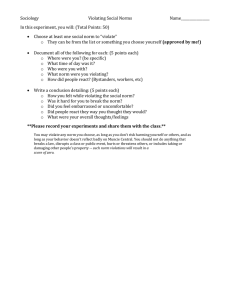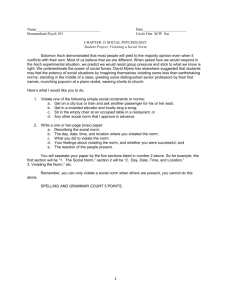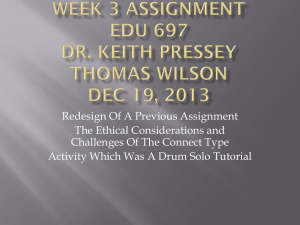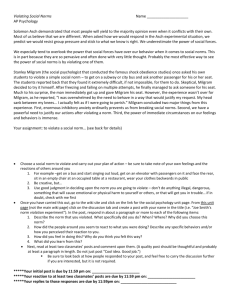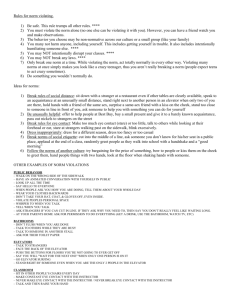Option E: Violating a Social Norm
advertisement
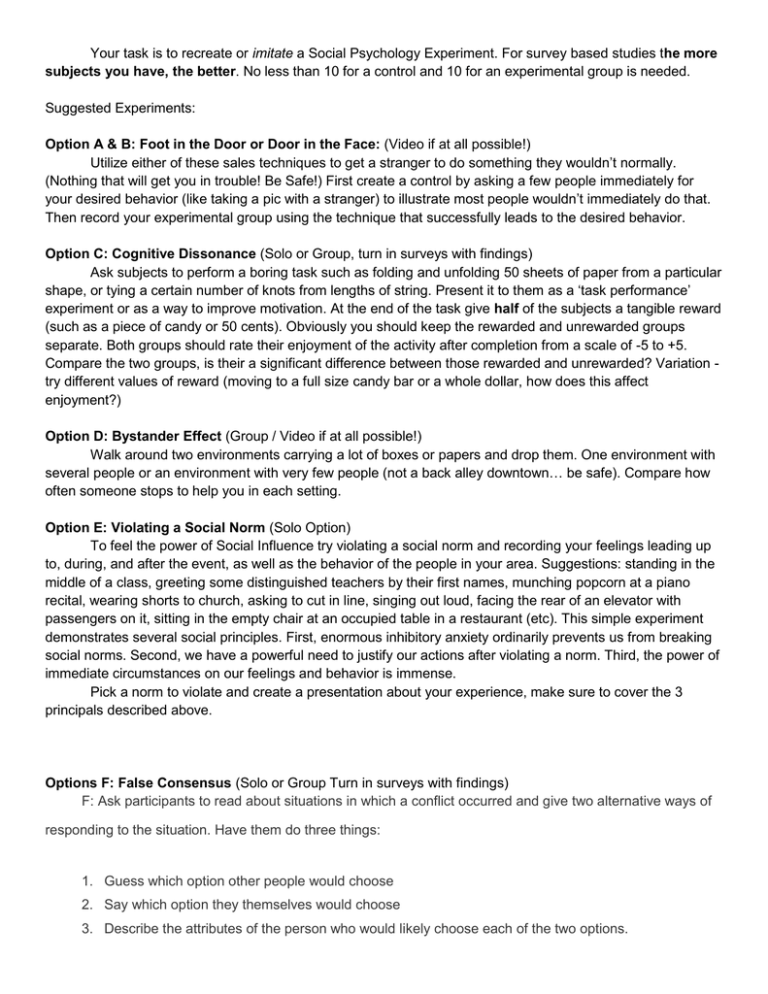
Your task is to recreate or imitate a Social Psychology Experiment. For survey based studies the more subjects you have, the better. No less than 10 for a control and 10 for an experimental group is needed. Suggested Experiments: Option A & B: Foot in the Door or Door in the Face: (Video if at all possible!) Utilize either of these sales techniques to get a stranger to do something they wouldn’t normally. (Nothing that will get you in trouble! Be Safe!) First create a control by asking a few people immediately for your desired behavior (like taking a pic with a stranger) to illustrate most people wouldn’t immediately do that. Then record your experimental group using the technique that successfully leads to the desired behavior. Option C: Cognitive Dissonance (Solo or Group, turn in surveys with findings) Ask subjects to perform a boring task such as folding and unfolding 50 sheets of paper from a particular shape, or tying a certain number of knots from lengths of string. Present it to them as a ‘task performance’ experiment or as a way to improve motivation. At the end of the task give half of the subjects a tangible reward (such as a piece of candy or 50 cents). Obviously you should keep the rewarded and unrewarded groups separate. Both groups should rate their enjoyment of the activity after completion from a scale of -5 to +5. Compare the two groups, is their a significant difference between those rewarded and unrewarded? Variation try different values of reward (moving to a full size candy bar or a whole dollar, how does this affect enjoyment?) Option D: Bystander Effect (Group / Video if at all possible!) Walk around two environments carrying a lot of boxes or papers and drop them. One environment with several people or an environment with very few people (not a back alley downtown… be safe). Compare how often someone stops to help you in each setting. Option E: Violating a Social Norm (Solo Option) To feel the power of Social Influence try violating a social norm and recording your feelings leading up to, during, and after the event, as well as the behavior of the people in your area. Suggestions: standing in the middle of a class, greeting some distinguished teachers by their first names, munching popcorn at a piano recital, wearing shorts to church, asking to cut in line, singing out loud, facing the rear of an elevator with passengers on it, sitting in the empty chair at an occupied table in a restaurant (etc). This simple experiment demonstrates several social principles. First, enormous inhibitory anxiety ordinarily prevents us from breaking social norms. Second, we have a powerful need to justify our actions after violating a norm. Third, the power of immediate circumstances on our feelings and behavior is immense. Pick a norm to violate and create a presentation about your experience, make sure to cover the 3 principals described above. Options F: False Consensus (Solo or Group Turn in surveys with findings) F: Ask participants to read about situations in which a conflict occurred and give two alternative ways of responding to the situation. Have them do three things: 1. Guess which option other people would choose 2. Say which option they themselves would choose 3. Describe the attributes of the person who would likely choose each of the two options. Option G: Research a cult (Solo Option) 1 Pick a real cult. 2 Identify from what socio economic background most of its members came from. 3 Identify the methods used to recruit members 4 Identify the methods used to brainwash members once they’ve joined 5 Identify the methods used to keep the members within the group after joining 6 Describe the feelings of members that survived or ‘escaped’ their cult (if possible). Make a presentation. Be sure to include and explain the effects of conformity, normative social influence, ostracism, central and peripheral route persuasion.
